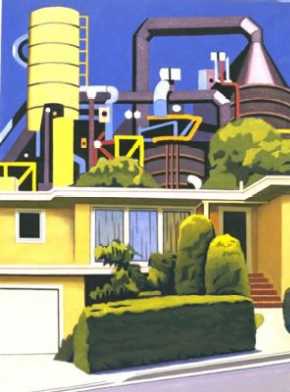| Stanford Art Spaces |
|---|
| April 12, 2002 to June 18, 2002, Stanford Art Spaces features an exhibit by two artists: |
|---|
|
Kendra Barron Paintings |
Warner Williams Paintings |
|---|
 Arch Right © 2002 |
 Yellow House With Refinery © 2002 |
| This exhibit is located on the Stanford University campus in four buildings: the Allen Center for Integrated Systems (CIS), Gates Computer Science, Terman Engineering Center, and Humanities and Sciences. Open 8:30 am to 5 pm, Monday through Friday. |
|---|
|
Most works are for sale directly from the artists. For information, contact M. Grossman, Curator, at (650) 725-3622 or marigros@stanford.edu |
| Kendra Barron |
|---|


|
The celebration of life and an ever expanding sense of awareness are the two themes influencing my work. I gravitate to places which inspire a sense of calm, appreciation, and introspection. That is why the San Francisco Conservatory of Flowers has long been a subject of mine. The sight of exotic plants, the feel of the humid air, the sound of gravel crunching under foot, the trickle of water, along with the smell of fir mulch... These sensory features present an intensely satisfying life experience along with a profound sense of serenity. For an artist who loves to create meditative spaces with her paintings, the conservatory is an ideal source of inspiration. The conservatory theme is particularly dear to me, because my godfather raised orchids. I remember how magical the glass houses filled with beautiful growing plants seemed to me as a child. It is no coincidence that my aunt, who was an artist, provided me with all the equipment of an oil painter when I was twelve. These two experiences fueled my senses and my joy in painting. At a time when support was being organized to refurbish the Conservatory of Flowers, I felt inspired to create a series of paintings based on the photographs I had taken over the years. It is my wish to have the images published as posters, note cards, and a calendar, with the proceeds going to the Conservatory Fund. I am very pleased to be able to share the original paintings at the Stanford Art Spaces. |
| Warner Williams |
|---|




For more Warner Williams art, click here. |
Warner Williams is a master for the ages, who takes as his subject matter motels, freeways, swimming pools, tract homes and power plants, and creates classics. He embraces an ordinary vernacular language and elevates it with a sense of craft and revelatory vision that makes drab subject matter into something luminous and telling about our times. He broke free of both the softness and sentimentality of landscape painting, as well as the structural boredom of it. One of his decisive innovations is the vertical tiered collage method of composition. Instead of the standard polar relationship of “foreground/background” or “earth/sky”, Warner proposed a dialogue among three or more distinct perspectives, sitting right on top of each other toward unity and wholeness. Warner has also reconciled any conflict between the artistic disciplines of abstraction versus representation. His work enjoys the best of both worlds, because his finer structures are mostly abstract forms and shapes dancing together, whereas his image is fully familiar and recognizable. He reminds the viewer of something real and familiar, and yet doesn’t allow the viewer to arrive at easy conclusions or file the experience away as “another nice landscape”. Warner’s use of sharp-edged shapes filled with solid colors enhances the effect of his elaboration of color theory. One aspect of this color theory is how certain versions of a primary color tend to recede “back” into the canvas, while other versions appear to “come out” toward the viewer. He is able to create a definite sense of space and light and depth in his architectural scenes. Warner’s oil paintings are neither just pleasant, escapist landscapes, nor are they just an angry critique of post-war car culture and suburbia (with its drabness, alienation, and pollution). He embraces the truth of what he finds in his environment and uses it to say something universal. In the midst of ordinary everyday reality exists that which is divine, bright, and beautiful. |
|
Most works are for sale directly from the artists. For information, contact M. Grossman, Curator, at (650) 725-3622 or marigros@stanford.edu |
| Go to top of this page | Return to SAS Schedule |
|---|